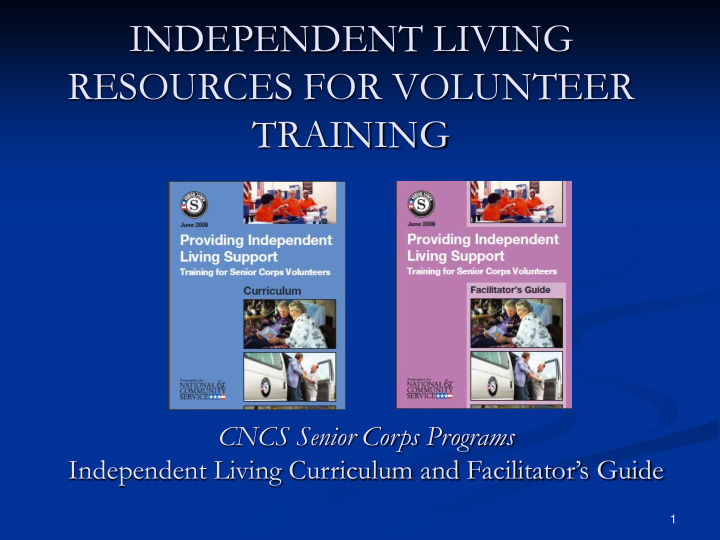



INDEPENDENT LIVING RESOURCES FOR VOLUNTEER TRAINING CNCS Senior Corps Programs Independent Living Curriculum and Facilitator’s Guide 1
LEARNING OBJECTIVES Become aware of and understand the 1. Independent Living Curriculum and Facilitator’s Guide. Learn about the Volunteer Training Plan 2. Process and resources. Consider how to use training modules, 3. volunteer training resources and identify next steps for training. 2
PURPOSE OF THE CURRICULUM & FACILITATOR’S GUIDE Standardized, easy-to-use curriculum for training volunteers in independent living services Creative training strategies for adult learners Adaptable, “stand alone” modules Tips and strategies for group facilitation End result: support volunteers and improve the quality of independent living services 3
HOW THE CURRICULUM CAN SUPPORT TRAINING Enhance or supplement content of current training Integrate new components into existing training Interactive exercises to enhance adult learning Opportunities for reflection and next steps 4
WHAT ARE THE MODULE TOPICS? Types of Independent Living Services 1. Becoming an Effective Care Partner 2. (Benefits to Volunteers) Understanding the Physical, Emotional, and Social 3. Challenges Effective and Respectful Communications 4. Understanding Dementia 5. Paying Attention to Body Language 6. Home Safety 7. Helping Clients Improve Quality of Life 8. 5
WHAT DO THE MODULES INCLUDE? 60-75 minute workshop that includes: Warm-up activity Key content information (brief lecture) Exercise for skill development Worksheet for reflection List of additional resources Facilitator tips throughout Feedback survey 6
WHAT ARE THE FACILITATOR’S GUIDE TOPICS? Ch. 1: Logistics Ch. 2: Adult Learning, Training Techniques and Application Ch. 3: Group Management Ch. 4: Training Evaluation and Self-Assessment 7
WHAT DO THE FACILITATOR’S GUIDE CHAPTERS INCLUDE? Frequently Asked Questions format to help you quickly find answers. Includes tips, strategies, and ways to work with a variety of different types of group participants. Geared toward the needs of new facilitators. 8
WHERE ARE THESE RESOURCES? http://nationalserviceresources.org/indep-living-training- curriculum 9
VOLUNTEER TRAINING PLAN What? How? Why? 10
WHY IS IT IMPORTANT TO PLAN VOLUNTEER TRAINING? Consistent and quality training improves: Volunteer performance and retention Quality of service to clients Sustainability of services Project functioning and impact 11
WHAT DOES THE VOLUNTEER TRAINING PLAN INCLUDE? Training Requirements Preparation Curriculum/Facilitator’s Guide Training Content and Resources Volunteer Training Plan/Schedule Training Agenda 12
WHERE ARE THESE RESOURCES? http://nationalserviceresources.org/indep-living-training-plan 13
RESOURCES The Resource Center http://www.nationalserviceresources.org Curriculum and Facilitator’s Guide: http://www.nationalserviceresources.org/ indep-living-training-curriculum Volunteer Training Plan Process: http://www.nationalserviceresources.org/ indep-living-training-plan 14
QUESTIONS? COMMENTS? • Cla udia Birming ha m, Co o rdina to r (650) 373-4963 c b irming ha m@ jb sinte rna tio na l.c o m • Anna Ma rie Sc hmidt (650) 373-4909 a sc hmidt@ jb sinte rna tio na l.c o m 15
Recommend
More recommend